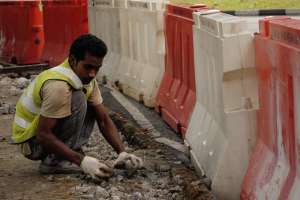
Over the past decade, many developing countries have made substantial progress toward reducing poverty, and remittances sent by migrant workers have hugely contributed to this progress.
In ADB’s developing member countries, remittances nearly tripled from $92 billion in 2005 to $246 billion in 2013. This huge flow of remittances helped reduced poverty levels, mostly through increased spending on food and other essential items, housing, and education. It is estimated that remittances helped reduce the poverty level by 1.5% in Bangladesh, 5% in Indonesia, and 2% in Viet Nam from 2000 to 2005.
The remittances growth is a reflection of high worker migration from developing countries to wealthier economies such as those in the Middle East. Migration and remittances have grown rapidly, however, with little or no support from the public sector or from donor agencies which have few projects to directly support migrant workers and remittances.
Moreover, we in fact know little about remittances beyond the headline numbers. How are they transmitted? How exactly do migrant worker households spend that money? How can we better channel remittances to reduce poverty? Have remittances really contributed to inclusive, sustainable economic growth in receiving countries? And above all, how can governments make use of remittances to create more domestic job opportunities, and thus reduce the need for so many workers to leave?
ADB recently hosted the Forum on Promoting Remittances for Development Finance to find answers to those questions. The discussions covered issues like impact on economic growth, household investments, access to finance and technology innovations, and investments. Here are a few takeaways:
- Remittances can contribute to economic growth if the receiving household saves or puts the money into the formal financial system which would channel the money into public and private investments.
- Households spend most of the remittances they receive. In Bangladesh, 84% of remittances is consumed. Only 14% is saved, mainly due to transaction costs such as fees to open a bank account, lack of trust in financial institutions, regulatory barriers like official identification documents that many poor people lack, a dearth of information and financial literacy, social constraints, and behavior barriers. Studies suggest more financial education helps households to save more.
- To channel remittances for investments, it is essential to expand access to formal financial services. Digital finance has an enormous potential to capture remittances in the formal financial system. In Bangladesh, only 15% of the population has access to banks, but 60% have mobile phones. “bKash,” the mobile-based banking service offered by the country’s BRAC Bank, has 15 million registered customers and daily transactions worth $26 million. Digital finance can help include poor people in the formal financial sector, and enable them to save and invest in financial assets.
- Capital market instruments such as diaspora bonds and securitization of future flow of remittances are available to capture remittances for investments on a national level. In Africa, Ethiopia, Ghana, and Kenya raised $400 million, $20 million and $154 million, respectively, through sovereign bond issuances targeting non-resident nationals willing to contribute part of their savings to their home countries. To tap diaspora investments, though, countries should develop the right structure, marketing and distribution channels, and build long-term relationships with the target investors.
So what is the way forward? The forum identified three potential areas for support:
- Improving financial education.
- Expanding digital finance.
- Promoting remittance-linked capital market instruments.
Both the public and the private sector, including donors, must think about concerted assistance in these areas. For example, governments can promote financial education for migrant workers before they go abroad. Donors can support developing financial sector infrastructure IT systems such as core banking system, e-payment and networks to promote digital finance. They can also help develop enabling legal and regulatory frameworks for remittance securitization and diaspora bonds. More essentially, governments and donors must have a vision to leverage remittances to develop viable local industries to generate local employment opportunities, so in the long run workers can find good jobs at home rather than migrate out of necessity.
This article was first published by ADB Development Blog.







Comments are closed.